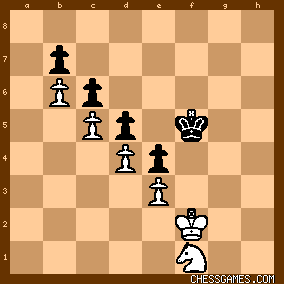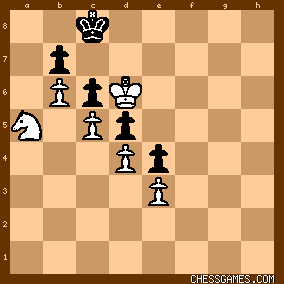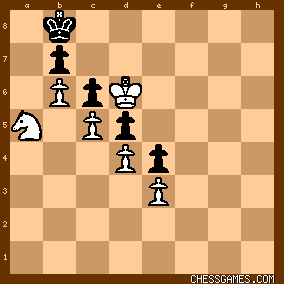|
< Earlier Kibitzing · PAGE 2 OF 2 ·
Later Kibitzing> |
| Jul-02-05 | | aw1988: I nominate tpstar's post for best ever. |
|
| Jul-02-05 | | fgh: Amazing endgame. |
|
| Jul-02-05 | | aw1988: Oh, yes, about the game- amazing. |
|
| Jul-02-05 | | fgh: <aw1988>: Of course, whenever you want, we can discuss the actual game instead of tpstar's posts :-) |
|
| Jan-24-09 | | WhiteRook48: Ok, that last position was just funny |
|
Jul-27-09
 | | Peligroso Patzer: The “interesting and instructive” (the phrase is from Alekhine in the tournament book, referring to the play after 39. ... Kxh4) finale of this game would never have occurred if Botvinnik had found a remarkable winning idea starting with 37.Qe5+! (which was also missed by Alekhine in his annotations in the tournament book, "Nottingham 1936", by Alekhine, Alexander, Russell Enterprises, Inc. ©2009, pp. 141-143). Based upon analysis using Rybka 3, it appears that the following would be best play for both sides: 37. Qe5+ Qxe5+ 38.dxe5 Kg6 39.Nf2 Kf5 40.Ng4! h5 41.Nf6 Kxe5 42.Nxh5 d4 43.exd4+ Kxd4 44.Kg3 Ke3 45.Nf6  . . |
|
Jul-18-18
 | | An Englishman: Good Evening: Amazing how Botvinnik realized that he could (perhaps had to?) give up both his g and h pawns to win. |
|
Jul-18-18
 | | offramp: <Peligroso Patzer: ...if Botvinnik had found a remarkable winning idea starting with 37.Qe5+! (which was also missed by Alekhine in his annotations in the tournament book, "Nottingham 1936", by Alekhine, Alexander, Russell Enterprises, Inc. ©2009, pp. 141-143).
Based upon analysis using Rybka 3...>
I tried this out using chessgames's Stockfish 8, which after 1 minute thinks that 37.Qg3 is the best, followed closely by 37.Qe5+. So Botvinnik was right after all. I also am surprised to see the list of authors of the book <"Nottingham 1936"> include a Mr Russell. That is Hanon W Russell, but how did he contribute? |
|
Jul-18-18
 | | offramp: I reread it and I see that the publishers is Russell Enterprises, he's not the co-author. I was thinking of Sam Sloan and the Ishi Press. |
|
| Jul-18-18 | | ChessHigherCat: <offramp: I was thinking of Sam Sloan and the Ishi Press.>
No you were thinking of the He-She Press, a Chinese laundry for cross-dressers. A very clever game with lots of subtleties, but from my experience playing computers recently it's very rare that you can't beat a king + an equal or slightly superior number of pawns with a king + a minor piece, because the extra piece gives the huge advantage of winning tempi (a Chinese game featuring uncouth arthritic elephants versus kindly but neurotic wombats) |
|
| Jul-18-18 | | Eduardo Leon: <Jim Bartle: In his book he (Tal) says he took particular pleasure in defeating in a tough endgame a player (can't remember who) who'd said something along the lines of "Tal is an excellent GM in the opening, a brilliant GM in the middlegame, and an ordinary GM in the endgame."> This is coming a little bit too late (only four years!), but I think you were thinking of Tal vs M Damjanovic, 1966 |
|
| Jul-18-18 | | PhilFeeley: An amusing ending would be 69...f2 70. Nd2 (or h2) f1(N)! 71. Nxf1 stalemate! So white has to move the knight away and it seems a draw I wish they'd played it out, because if white marches his king back, black just follows with his. Not so easy as it looks. Can anyone show various continuations? |
|
Jul-18-18
 | | Honza Cervenka: <PhilFeeley: An amusing ending would be 69...f2 70. Nd2 (or h2) f1(N)! 71. Nxf1 stalemate! So white has to move the knight away and it seems a draw> After 69...f2 white can go simply to grab the f-Pawn by his King, and the rest is trivial win in ending with extra piece. It will end with sac of Knight for two black Pawns and transition into a won Pawn ending. |
|
Jul-18-18
 | | Honza Cervenka: For exanple, 69...f2 70. Kd7 Kb8 71. Ke6 Kc8 72. Kf5 Kd7 73. Kg4 Ke6 74. Kg3 Kf5 75. Kxf2 Kg4 76. Kg2 Kf5 77. Kg3 Kg5 78. Nd2 Kf5 79. Kh4 Kf6 80. Kg4 Kg6 81. Kf4 Kf6 82. Nxe4+ dxe4 83. Kxe4 etc. |
|
Jul-18-18
 | | fiercebadger: Whites king comes back takes on f2 , then puts the knight on a5 game over |
|
| Jul-18-18 | | Ironmanth: Wonderful execution; ideas/technique belong in everyone's endgame quiver. Y'all have a great day! |
|
Jul-18-18
 | | piltdown man: Fantastic game! Kudos to both players. |
|
| Jul-18-18 | | The Kings Domain: Fun endgame. |
|
Jul-18-18
 | | Check It Out: <PhilFeeley> here is what I came up with: 69...f2 70.Kd7 Kb8 71.Ke6 Kc8 72.Ke5 Kd7 73.Kf4 Ke6 74.Kg3 Kf5 75.Kxf2 Kg4 76.Nd2 Kf5 77.Kg3 Kg5 78.Nxe4+ dxe4 79.d5 cxd5 80.c6 etc. Other black king moves allow white to nab two pawns for the knight and it's all over as well. |
|
Jul-18-18
 | | Check It Out: I see the esteemed <Honza Cervenka> already layed it out. |
|
| Jul-18-18 | | morfishine: Unique and fascinating game, especially the endgame Curiously, Sir GA Thomas frequently found himself inveigled in such situations, usually ending up on the short end for some odd reason (based on his strength) ***** |
|
| Jul-18-18 | | Gregor Samsa Mendel: <morphshine>--A game Thomas played, from the same tournament, where he managed to salvage a draw from an inferior endgame: Vidmar vs G A Thomas, 1936 |
|
Jul-18-18
 | | PawnSac: < PhilFeeley: Can anyone show various continuations? > Certainly!
< ENDGAME CLARIFCATION > < Honza Cervenka: For exanple, 69...f2 70. Kd7 Kb8 71. Ke6 Kc8 72. Kf5 Kd7 73. Kg4 Ke6 74. Kg3 Kf5 75. Kxf2 < Kg4 76. Kg2?! > Kf5 77. Kg3 Kg5 78. Nd2 Kf5 79. Kh4 Kf6 80. Kg4 Kg6 81. Kf4 Kf6 82. Nxe4+ dxe4 83. Kxe4 etc. > yes, the knight for 2 pawn sac as presented does win, BUT < 75. ..Kg4 76. Kg2?! > is a double blunder. White can actually do better. Starting from the final position when black resigned... < PHASE 1 ; White wins the F pawn > 69. Kc8 f2 70. Kd7 Kb8 71. Ke6 Kc8 72. Kf5 Kd7 73. Kg4 Ke6 74. Kg3 Kf5 75. Kxf2 DIAGRAM 1.. BLACK TO MOVE:

click for larger viewA first principle of endgame play is to COUNT SQUARES. White's knight can capture the B pawn in 4 moves (visualize the path.. Nd2-b3-a5-xb7). Therefore, black can move to any square from which he can reach c8 in 3 moves! (e6 or f6) If he moves to the G file, he is one file too far away to defend the B pawn. Then, white could win ALL the black pawns by force if he wished (but it's not necessary in order to mate). for example.. 75. ..♔g4? 76.♘d2 ♔f5 77.♘b3 ♔e6 78.♘a5 ♔e7 79.♘xb7 ♔d7 80.♘a5 ♔c8 81.♘xc6 ♔b7 82.♘b4 ♔c8 83.c6 ♔d8 84.b7 ♔c7 85.♔g3 ♔d8 (if ♔b8 86. ♘a6+ ♔a7 87. b8=♕+ ♔xa6 88. c7 ♔a5 89. c8=♕ ♔a4 90. ♕a6# ) 86.b8♕+ ♔e7 87.♕h8 ♔e6 88.♕g7 ♔f5 89.♘xd5 ♔e6 90.♕d7+b7 ♔c7 85. ♔g3 ♔d8 86. b8=♕+ ♔e7 87. ♕h8 ♔e6 88. ♕g7 ♔f5 89. ♘xd5 ♔e6 90. ♕d7# < PHASE 2 ; White sets up the knight sac. > Black is able to retreat and defend the pawn in 3 moves. Thereafter he is tied down to a8/b8/c8. White simply advances the K to d6, then captures the C pawn with the knight. variation a: Kf6 76. Nd2 Ke7 77. Nb3 Kd7 78. Na5 Kc8 79. Kg3 Kb8 80. Kf4 Kc8 81. Ke5 Kb8 82. Kd6 Kc8 DIAGRAM 2: White to move

click for larger viewNow white can play Nxc6 bxc Kxc6 Kb8 b7! when black is forced to move the K to a7.
Then white plays Kc7 and the pawn queens. BUT.. if black is clever and moves his
king as follows:
variation b: Ke6 76. Nd2 Kd7 77. Nb3 Kc8 78. Na5 Kb8 79. Kg3 Kc8 80. Kf4 Kb8 81. Ke5 Kc8 82. Kd6 Kb8 DIAGRAM 3: White to move

click for larger viewwe have the same position as above but with the black K on b8. If white now plays Nxc6 bxc Kxc6 Kc8! then if white pushes the pawn b7+ Kb8 now white must abandon the pawn since Kb6 is stalemate. Now, here is why i mention this.
One of the saddest things in chess is to have a winning position and lose on time. Accurate play is all well and good, but if you do not immediately see the winning path, AND are low on time, play practical chess. Sac the knight and take all the pawns! ( Nxc6 px Kx Kc8 Kxd5 K-any Kxe4!) The worst that can happen is that your flag drops and the game ends A DRAW because black does not have sufficient material to theoretically mate!
In a real game even with extreme time pressure, I would play Kd7!
Ka8 Nxc6 px Kx Kb8 b7! forcing the same position as from diagram 2.
knowing that even in a blitz speed time scramble i couple play for
a mate in under 10 seconds. BUT if you are not that confident
TAKE ALL THE PAWNS and prevent a loss, then if you have sufficient
time, continue for the win.
But the real answer is to study and practice these endgame
positions so that in a real game with time pressure you can
play the right ideas confidently. |
|
| Jul-19-18 | | Howard: As I recall, the tournament book laid out a four-step process detailing exactly how Botvinnik should go about winning this lengthy ending. He followed that method to the letter.
In other news, what WAS Botvinnik's best option on the 37th move? Looks like 37.Qe5+, if ya ask me. |
|
Sep-03-18
 | | fiercebadger: Kd7 only move , a long trek back to f2 but the party begins ..surely bottvinik has a vodka then ? |
|
 |
|
< Earlier Kibitzing · PAGE 2 OF 2 ·
Later Kibitzing> |





